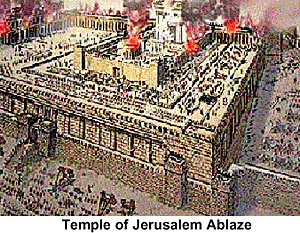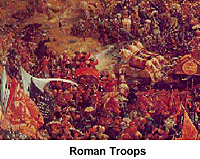 The Roman-Judaeo War Of 66-74 AD.
The Roman-Judaeo War Of 66-74 AD.
Author: James Bloom
Saga Publications, 135 pages, Spiralbound. $30
Temple of Jerusalem Ablaze
From the outset I have to 'fess up to being a ringer. I regularly play Terry Gore’s Ancient Warfare at the big eastern U.S. gaming conventions. So what follows is an honest and balanced review of Jim Bloom’s recently published campaign study by someone predisposed to find favor.
At least 25 years ago my friend Dan and I attended an Origins convention in the Philadelphia area (1976, in Chester, PA, I think) and met Fred Schachter and Steven Weiss, the designers of a new and exciting board game, The Siege of Jerusalem (TSJ), just published by their fledgling company, Historical Perspectives. Fred in particular was working the marks at the con, pulling passerby’s into marathon sessions of TSJ, till he had at least 10 copies of the game spread across multiple tables with dozens of newbies happily playing. Dan and I purchased our own copies, and indeed we continued to purchase editions of the game as it evolved through several versions until it was finally acquired and released by Avalon Hill in 1989.
Especially exciting was the introductory scenario, modeling the attempted coup d’main by the 12th Legio Fulminata under the command of the Syrian Governor, Cessius Gallus, on the north wall of the city in November, 66 (all dates unless otherwise indicated are A.C.E.). That attempt failed, and the Legio Fulminata was mauled by Eliezer ben Yair’s Zealots as it fled westward through the Beth-Horon pass. A fiasco for the Romans, but what a game!
It should therefore come as no surprise that I have eagerly anticipated the publication of Jim Bloom’s The Roman-Judaeo War of 66-74 AD (RJW) since it was first announced last year by Saga Publications. RJW is a spiral bound, 8” by 11” booklet of 135 pages, divided into 42 short chapters, with 11 maps (many in color), technical appendices, a large bibliography, and a set of seven color photographs of the wonderful, special purpose dioramas created by master figure painter Ted Willcock expressly for RJW, which accurately depict the arms and armor – in typical campaign scenes – of the combatants. That Terry Gore would undertake such an ambitious project this early in the life of his fledgling Saga Publications immediately brought to mind the redoubtable Schachter and Weiss. As Bloom relates, there were three periods of Jewish rebellion against the Roman empire during the period 66 - 135, the first being the best documented and the subject of his book, the second being the so-called Quietus War of 115-117, and finally, the Bar Kochba revolt of 132-135. Bloom’s book relies heavily on the accounts of Flavius Josephus, the Jewish War, and The Life of Flavius Josephus, but Bloom has carefully sifted through the critical literature on this material to extract the best modern interpretations (including his own unique contributions).
 Roman Troops
Roman Troops
What made the Jewish province so problematical for Roman rule was in Bloom’s view the very strong Jewish national identity embodied in the corpus of religious writings underlying the Judaean state. For an interesting interpretation of the historical roots of that foundation, I recommend the recent (and controversial) The Bible Unearthed by Israel Finkelstein and Neil Asher Silberman (my favorite read of the summer just passed). In a way, the Bloom and the Finkelstein-Silberman books present matching bookends for the stories of the origins and the demise of Judaea and temple-based Judaism.
It is Bloom’s thesis that the Roman-Judaeo War was won and lost in the opening campaigns of the conflict, when the factionalized and fractured leadership of the competing Jewish contingents failed to adequately plan a perimeter defense in depth for the serious counterthrust Rome may have been expected to mount, following the expulsion of her garrison from Jerusalem and the humiliation of the Legio Fulminata (it lost it’s eagle!). Thus it was that Josephus was himself an important player in the war, as he was one of the regional commanders whose early failures loomed large later when the path to Jerusalem offered little resistance, and the fate of the city was sealed well before the legions of Vespasian and Titus arrived to make it so.
RJW is a valuable addition to the wargamer’s and the ancient historian’s libraries. Its technical appendices are no less valuable than the text itself, indeed, I found them very interesting as they contain a good share of the military analysis of numbers and tactics. The large bibliography is also very handy for anyone who wishes to follow-up by delving deeper into full literature on the subject.
A brief word or two is in order regarding that which RJW is not. Since it the product of a (struggling to make it) start-up company, it is not the slick publication one expects from Osprey or Warhammer. It is a modest physical product of good quality. Readers pay a premium for such products. Second, it is not an academic print, so the occasional outbreak of purple prose, or the odd awkward phrase or two, may be expected. Generally, the booklet is well written. Finally, it not actually a wargaming book; it has no scenarios and no detailed army lists of figures and stands tailored for any particular rules set. This certainly is a departure from Saga’s growing product line. But it certainly is a major sourcebook for any gamer who wants to gin up a scenario, or a campaign, or an army list for the Roman-Judaeo war(s). And Ted Willcock’s photos provide wonderful templates for gamers painting figures for this or any ancient warfare.
I sure got my money’s worth.
Back to Cry "Havoc!" #41 Table of Contents
Back to Cry "Havoc!" List of Issues
Back to MagWeb Master Magazine List
© Copyright 2003 by David W. Tschanz.
This article appears in MagWeb.com (Magazine Web) on the Internet World Wide Web. Other articles from military history and related magazines are available at http://www.magweb.com